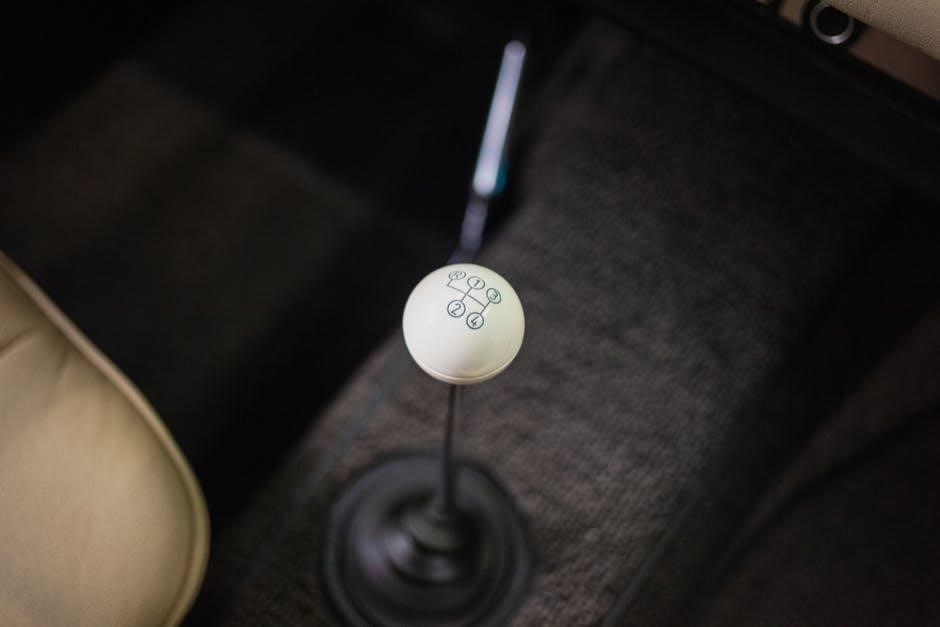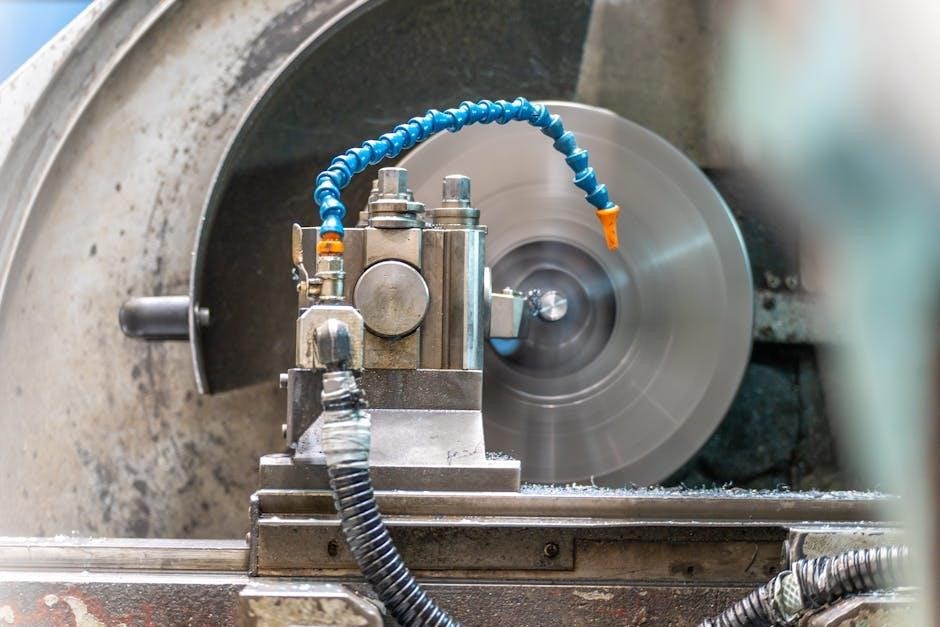how to change manual gearbox oil
How to Change Manual Gearbox Oil: A Comprehensive Guide
Changing manual gearbox oil ensures optimal performance and longevity․ Use the correct oil type, such as ATF for some gearboxes, and specialized tools like an M16 spline bit․ Always consult your vehicle’s manual for specs and avoid overfilling, as seen in cases like the Ducato gearbox․
Understanding the Importance of Gearbox Oil
Gearbox oil is essential for maintaining the health and functionality of a manual transmission․ It lubricates moving parts, prevents corrosion, and reduces wear caused by friction․ Without proper lubrication, gears can overheat and degrade, leading to costly repairs․ Gearbox oil also helps protect synchronizers and bearings, ensuring smooth shifting and consistent performance․ Using the wrong type of oil or neglecting to change it can cause premature wear and potentially damage the transmission․ Some gearboxes, like the Type 9, require specific oils such as ATF to ensure proper lubrication for all gears, including 5th gear․ Overfilling, as seen in cases like the Ducato gearbox, can also cause issues, so adhering to the manufacturer’s guidelines is crucial․ Regular oil changes extend the lifespan of the gearbox and prevent major failures․ Always consult your vehicle’s manual for the correct oil specifications to avoid compatibility issues and ensure optimal performance․

Preparing for the Oil Change
Before starting the oil change, gather all necessary materials to ensure a smooth process․ You will need a drain pan, a socket wrench or ratchet, the appropriate socket size for your gearbox drain plug, and new gearbox oil that matches your vehicle’s specifications․ Some gearboxes may require a specialized tool, such as an M16 spline bit, to remove the drain or filler plugs․ Always check your vehicle’s manual to confirm the correct oil type and capacity, as using the wrong oil can lead to damage․ For example, some gearboxes, like the Type 9, require ATF for proper lubrication․ Additionally, consult online resources or forums if you’re unsure about the oil specs or tools needed․ It’s also important to consider the debate about whether to change the gearbox oil at all, as some manufacturers, like Jaguar, may not recommend it due to “sealed for life” policies․ Ensure you have protective gloves and eyewear for safety․ Finally, warm up the engine by driving for a few minutes to help the oil drain more easily․ Proper preparation ensures the job is done correctly and safely․

Locating and Identifying the Gearbox Oil Plug
Locating the gearbox oil plug is a critical step in the oil change process․ The plug is typically found on the underside or side of the gearbox, depending on the vehicle’s make and model․ In some cases, such as the Type 9 gearbox, the plug may require a specialized tool, like an M16 spline bit, to remove․ Always consult your vehicle’s manual or online resources to confirm the location and type of plug used․ For example, certain gearboxes may have both a drain and filler plug, which can be confusing․ Ensure you identify the correct plug to avoid damage or unnecessary complications․ If you’re unsure, consult forums or repair guides specific to your vehicle․ Proper identification ensures you can proceed safely and efficiently with the oil change․ Take your time to locate and verify the plug before attempting to remove it, as mistakes can lead to costly repairs․ Once identified, double-check that you have the right tools and oil ready for the next steps․

Draining the Old Oil

Draining the old oil is a straightforward process that requires care to avoid spills and contamination․ Start by positioning your vehicle on a level surface and ensuring the engine is warm for optimal oil flow․ Locate the drain plug, which may require a specialized tool like an M16 spline bit, as seen in some gearboxes․ Place a drip pan or container underneath to catch the old oil․ Slowly unscrew the plug using a wrench or socket, being prepared for the oil to flow out quickly․ Allow the oil to drain completely before replacing the plug․ Be cautious, as the oil may still be hot․ If your vehicle has a filler plug, ensure it is closed to prevent contamination․ Once the oil has stopped dripping, tighten the drain plug to the specified torque to avoid leaks․ Inspect the old oil’s condition to check for debris or discoloration, which could indicate wear․ Properly dispose of the used oil and filter, as they contain hazardous materials․ Always refer to your vehicle’s manual for specific instructions, as some gearboxes, like sealed units in Jaguars, may not require oil changes․ Safety gloves and goggles are recommended to protect against splashes․ After draining, you’re ready to refill with fresh oil․

Refilling with New Oil

Refilling your manual gearbox with new oil is crucial for maintaining its performance and longevity․ Ensure you use the correct type of oil, as specified in your vehicle’s manual or manufacturer’s recommendations․ Common options include ATF for certain gearboxes, like the Type 9, or semi-synthetic oils such as Motylgear or Amsoil․ Pour the oil slowly through the filler plug using a funnel to avoid spills․ Be careful not to overfill, as this can lead to leaks or damage․ For most gearboxes, the recommended oil level is just below the filler plug hole․ If unsure, consult the owner’s handbook or a professional․ Some vehicles, like Jaguars, may have sealed gearboxes that do not require oil changes․ After refilling, replace the filler plug securely and tighten it to the recommended torque․ Wipe any spilled oil with a clean cloth and check for leaks around the plugs․ Dispose of any rags and materials responsibly․ Finally, take the vehicle for a short test drive to circulate the new oil and ensure smooth operation․
Checking for Leaks and Testing
After refilling the gearbox oil, it’s essential to check for leaks and test the system to ensure everything functions properly․ Start by inspecting the drain and filler plugs for any signs of leakage․ Turn the engine on and let it run for a few minutes to circulate the new oil․ Shift through all gears slowly, including reverse, to ensure smooth operation and monitor for any unusual noises or vibrations․ If you notice any leaks, tighten the plugs or replace the gasket if necessary․ Take the vehicle for a short test drive to verify that the gearbox performs smoothly and without hesitation․ Pay attention to any signs of malfunction, such as slipping gears or abnormal sounds․ If everything feels normal, your gearbox is ready for continued use․ Always refer to your vehicle’s manual for specific testing procedures, as some models may require additional steps; Properly dispose of any materials used during the process, such as rags or drip pans․ A well-maintained gearbox will provide years of reliable service, ensuring optimal performance and reducing the risk of costly repairs;
Disposing of Used Oil Responsibly
Properly disposing of used gearbox oil is crucial for environmental protection․ Collect the old oil in a leak-proof container with a tight-fitting lid to prevent spills․ Avoid mixing the used oil with other household waste, chemicals, or liquids, as this can contaminate recycling processes․ Many auto repair shops, service centers, and recycling facilities accept used oil for proper disposal; Check with local authorities or waste management services for designated drop-off locations․ Do not pour used oil down drains, as it can harm sewer systems and waterways․ Additionally, dispose of oil filters and rags responsibly, as they may contain residual oil․ Some communities offer special collection events for hazardous waste, which include used oils․ By taking these steps, you help protect the environment and comply with regulations․ Remember, responsible disposal is a key part of maintaining your vehicle and reducing its environmental impact․ Always prioritize eco-friendly practices when handling used automotive fluids․

Maintenance and Record Keeping
Regular maintenance and meticulous record keeping are essential to ensure the longevity and optimal performance of your manual gearbox․ Always adhere to the recommendations outlined in your vehicle’s owner’s manual, as some gearboxes may have specific requirements or be sealed for life, as seen in certain models like Jaguars․ Schedule future oil changes based on the manufacturer’s guidelines, typically determined by mileage or time intervals․ Keep a detailed log of each maintenance activity, including the date, mileage, type and amount of oil used, and any additional services performed․ This log serves as a valuable reference for tracking the vehicle’s history and can be beneficial if you decide to sell the vehicle․ Periodically inspect the gearbox for signs of wear or leaks, addressing any issues promptly to prevent further damage․ Using high-quality oils that meet or exceed manufacturer specifications, such as synthetic options like Amsoil or Motul, ensures better lubrication and protection․ Avoid using incorrect oil types or overfilling, as these can lead to performance issues, as noted in cases like the Ducato gearbox․ By maintaining your gearbox and keeping accurate records, you enhance its performance and extend its lifespan, preventing premature wear and potential failures․
Considering Professional Help
While changing manual gearbox oil can be a DIY task, there are situations where seeking professional help is advisable․ If you lack experience or confidence in performing the oil change, consulting a trained mechanic ensures the job is done correctly․ Some gearboxes, such as those in certain Jaguar models, are designed to be sealed for life, and dealers may not recommend DIY oil changes due to manufacturer policies․ Additionally, if your vehicle requires specialized tools, like an M16 spline bit for drain plugs, and you don’t have access to them, a professional can provide the necessary expertise․ If you’re unsure about the correct oil type or quantity, a mechanic can guide you to avoid using incompatible oils, which could damage the gearbox․ Furthermore, if you’re considering a transmission swap or suspect underlying issues with your gearbox, professional assistance is crucial․ Always consult your vehicle’s handbook for specific recommendations and consider reaching out to a trusted technician if you’re in doubt․ This ensures your gearbox remains in optimal condition and avoids potential costly repairs down the line․

Sharing Your Experience

Sharing your experience with changing manual gearbox oil can be incredibly valuable for others․ Many car enthusiasts and DIYers benefit from tips, advice, and lessons learned during the process․ For instance, discussing the importance of using the correct oil type, like ATF for certain gearboxes, can help others avoid costly mistakes․ Highlighting the need for specialized tools, such as an M16 spline bit, ensures others are prepared․ Additionally, sharing insights about specific vehicle models, like the Jaguar sealed-for-life policy, can guide others in making informed decisions․ Online forums and communities are great platforms for exchanging knowledge, fostering collaboration, and building trust among DIY enthusiasts․ By sharing your experience, you contribute to a collective understanding and empower others to tackle similar projects confidently․ This exchange not only enhances individual skills but also strengthens the DIY community as a whole․ Your story could be the key to someone else’s success in maintaining their vehicle’s gearbox․
